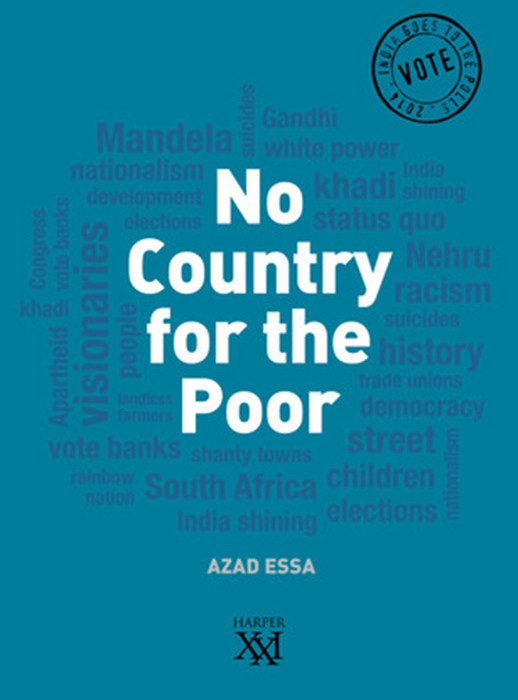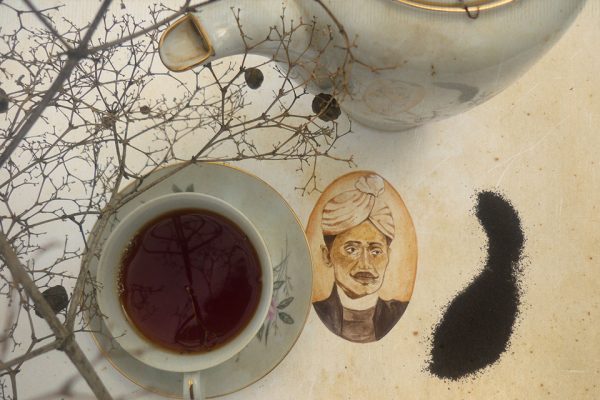A Review of Azad Essa’s No Country For the Poor By Thomas Crowley
Spoiler alert! I am going to begin this column with the closing words of the e-book under review. Those words: “business arrangements posing as democracies.” This damning phrase is part of a larger indictment of modern-day India and South Africa.
The e-book in question is the slim but moving No Country for the Poor by journalist (and fellow Kindle columnist) Azad Essa. In this e-vignette (for lack of a better term), Essa begins with the death of Nelson Mandela, using this as a launching pad for musings about his experiences as a person of Indian descent living in South Africa (and occasionally returning home to visit the ‘motherland’) and about the larger economic and political structures tying together South Africa and India.
The two countries’ histories are uniquely interlinked, in part because of the large population of ethnically Indian people in South Africa, in part because of their shared histories of European colonialism, in part because African National Congress (ANC) leaders, particularly Nelson Mandela, were inspired by the leading lights of the Indian National Congress (INC), most notably Nehru and Gandhi. As Essa reveals, the inspiration has flowed in both directions; Yasin Malik, the leader of the Jammu Kashmir Liberation front, once told Essa that Mandela’s autobiography inspired him to turn from armed struggle to non-violent resistance.
The parallel with the INC is intriguing. Both the ANC and the INC succeeding in building mass movements, both fought against oppressive systems of domination, both came to power and promised to usher in a new era of progress and equality, and both have tragically disappointed. In both countries, in retrospect, what occurred seems less like a revolution, and more like a peaceful transfer of power, from one set of elites to another.
Essa’s piece gives a personal twist to these historical linkages. Though he grew up in Durban, he encountered his first serious critique of Mandela when studying in Delhi. That critique, not surprisingly, came from Arundhati Roy, who in the same speech criticized the so-called ‘development’ in India that had left so many dispossessed and destitute. And that points to the similarity that forms the core of Essa’s piece: the neoliberal path taken by both India and South Africa, and the destruction that has followed in its wake. “No country for the poor” is a statement that describes India and South Africa equally well.
While Essa marshals a range of alarming figures about the depth of poverty and suffering that still exists in both countries, the strongest part of the piece comes in the form of an extended meditation on the movie Pardes, and what it meant to watch Pardes, in Mumbai, as an NRI. In Essa’s words, the film “presents a fervent clash of civilizations: the Indian who is no longer Indian for they have lost the cultural symmetry with their desh, demonstrating little care for the rural, puritanical India.” At the time, he “hungrily” lapped it up, reconnecting with his homeland, but looking back, he sees it for what it is: “propagandist cinema” portraying “a better place of plush green fields, voluptuous, subservient women and family dramas neatly packaged in cotton wool.” This image, of course, is false, just as much as the ‘India Shining’ campaign, with its more urban focus.
False, too, are the promises of a better life for most black South Africans in the post-apartheid era. The ANC, though still by far the most dominant political party in the country, is subject to increasing criticism as people realize that the overall structure of the economy and the polity has not changed in any radical way. Here, the parallel with the INC is intriguing. Both the ANC and the INC succeeding in building mass movements, both fought against oppressive systems of domination, both came to power and promised to usher in a new era of progress and equality, and both have tragically disappointed. In both countries, in retrospect, what occurred seems less like a revolution, and more like a peaceful transfer of power, from one set of elites to another.
Of course, the parallel should not be taken too far – India and South Africa are vastly different countries, with their own peculiar histories, and their own sets of conflicts, complexities, injustices, struggles and triumphs. The ANC, for instance, has a longer, deeper history of radicalism and militancy; though the INC has, at times, flirted with the Left (witness Nehru’s brief fascination with the Bolsheviks), it has, for most of its history, been an organ of elite control. The nature of the oppression being fought was different for these two parties as well; colonialism and apartheid, while both means of exploitation often justified by racist propaganda, are very different beasts.
To paraphrase Margaret Thatcher; unless it was to begin a concerted attack on international capital, the post-apartheid government would quickly be incorporated into the neoliberal world order (where India had recently found its place). Essa summarizes Arundhati Roy’s take on the matter: “Mandela was ‘a magnificent man’ who was held hostage by the project of corporate globalization.” Unfortunately, the hostage-taking exercise was quite successful.
Perhaps, though, the biggest difference between ANC and INC is that they came to power in very different times. When the Nehruvian era of Indian politics began, the Cold War was just heating up, non-alignment held wide appeal, and – even amongst capitalist countries (which included India, despite its false rhetoric of socialism) – state planning and state involvement in the economy was widely assumed to be the only way forward. When Mandela came to power, ‘there was no alternative’, to paraphrase Margaret Thatcher; unless it was to begin a concerted attack on international capital, the post-apartheid government would quickly be incorporated into the neoliberal world order (where India had recently found its place). Essa summarizes Arundhati Roy’s take on the matter: “Mandela was ‘a magnificent man’ who was held hostage by the project of corporate globalization.” Unfortunately, the hostage-taking exercise was quite successful.
Towards the end of his piece, Essa discusses the Marikana miner’s strike, a wildcat strike that ended, infamously, with the police opening fire and killing thirty-four workers. The strike was a tragedy, and a reminder of the bad-old-days of apartheid, but, unsurprisingly, says Essa, the middle class was unmoved, and in fact mocked the demands of the workers. Essa reports, “The miners of Marikana were described as ‘militant’ ‘dogmatic’, and ‘armed’ – as the black folk were once described in this country.” Striking workers in India, most notably at Maruti Suzuki, have been subjected to much the same treatment; if anything, they are even more forcefully dismissed (or ignored outright) by the mainstream media.
And yet, these signs of labor unrest, in both South Africa and India, also suggest that neoliberal rule, as presided over by ANC and INC, is starting to meet increasingly stiff resistance. Essa says that, these days, India and South Africa are “kindred spirits in their celebration of inequality.” One hopes that, as resistance movements continue to build, the countries can be kindred spirits in something much nobler.














